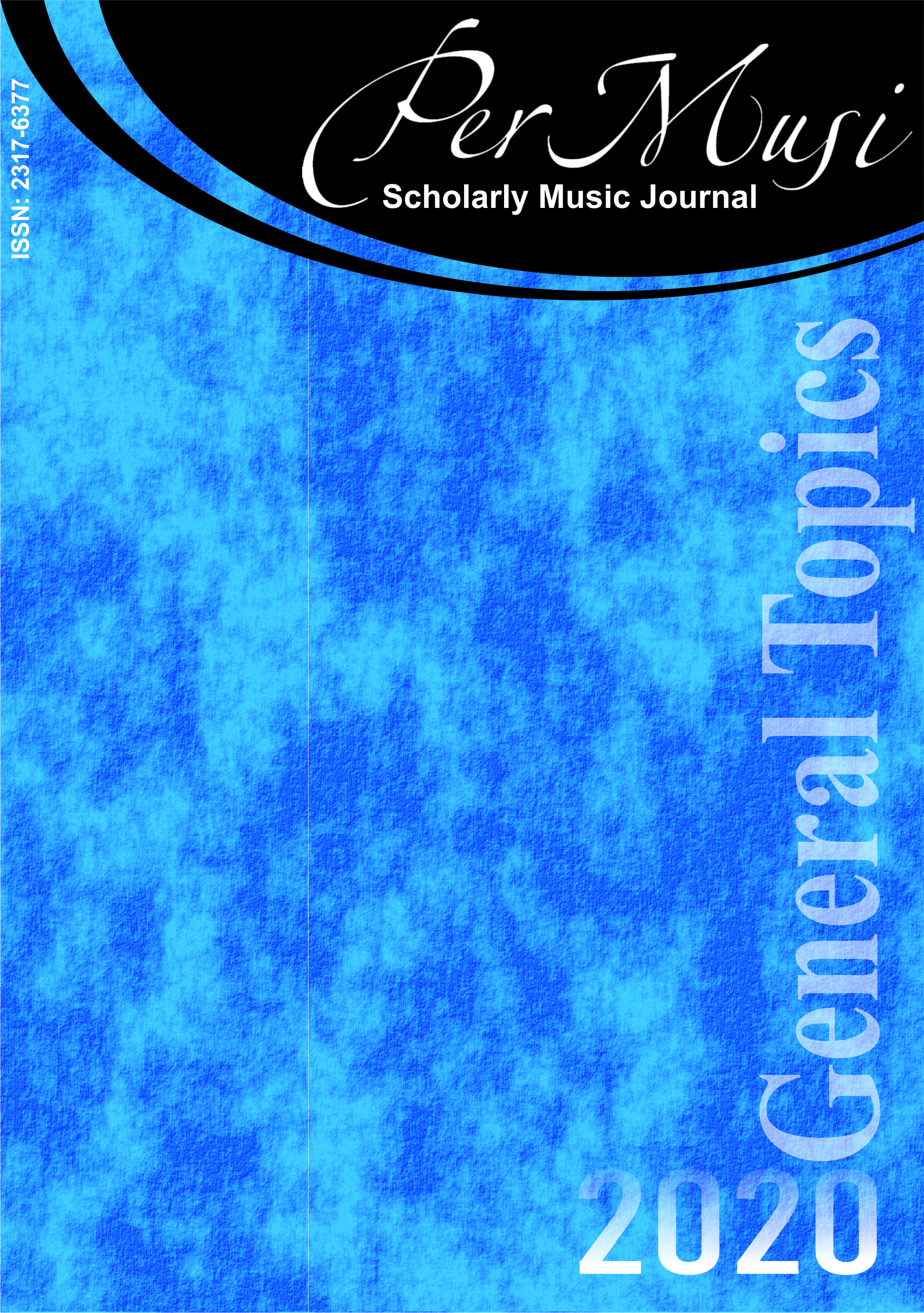Experiência formativa na aula de Fisioterapia
Instrumentalização da Música
DOI:
https://doi.org/10.35699/2317-6377.2020.19311Palavras-chave:
Dalcroze, Formação musical, Música, Movimento, FisioterapiaResumo
A música pode tornar-se um instrumento de mudança terapêutica, por si só ou incorporada noutras disciplinas das Ciências da Saúde. O objetivo do nosso estudo foi a elaboração de atividades musicais que pudessem ser relevantes para o tratamento de diferentes enfermidades da Fisioterapia. Os estudantes, no contexto do tema "Musicoterapia", através de encenações, propuseram diferentes atividades em torno das quais refletiram sobre a sua utilidade nos casos e campos profissionais propostos, com a intenção de concluir a sua utilidade e aplicabilidade em Fisioterapia. Os peritos em Fisioterapia analisaram os resultados e mostraram as suas revisões para a melhor adaptação ao espaço de fisioterapia. Especialistas e estudantes concordaram que certos conceitos poderiam ser adaptados para serem utilizados em Fisioterapia, instrumentalizando assim a Música dentro e para este espaço, para além da sua compreensão como um elemento auditivo de fundo para relaxamento.Referências
Albes, Mayra; Gomes, Mansueto; Gonçalves, Jessica; Saquete, Paulo Ricardo; Bernardone, Micheli, y Vitor Oliveira. 2016. “Effect of music therapy on blood pressure of individuals with hypertension: A systematic review and Meta-analysis”. International Journal of Cardiology 214: 461-464.
Ashburn, Ann; Robinson, Judy; Wiles, Rose; Hulbert, Sophia; Fitton, Carolyn; Kundel, Dorit; Roberts, Lisa; Pickering, Ruth M., y Helen Clare Roberts. 2015. “Dancing with Parkinson’s disease: a qualitative exploration of the views and experience of participants in a feasibility study”. Physiotherapy 101 (1): es90-es91.
Becker, Emily, y Stacey Dusing. 2010. “Participation is possible: A case report of integration into a community performing arts program”. Phsysiotherapy Theory and Practice 26 (4): 275-580.
Bellieni, Carlo Valerio, Cioncoloni, David, Mazzanti, Sandra, Bianchi, Maria Elena, Morrone, Ilenia, Becattelli, Rossana, Perrone, Serafina, y Giuseppe Buenocore. 2013. “Music provided through a portable media player (iPod) blunts pain during physical therapy”. Pain Management Nursing 14 (4): e151-e155.
Benenzon, Rolando. 1989. Manual de Musicoterapia. Buenos Aires: Paidós.
Bernabé, Maria del Mar. 2016. “Características de la formación musical en el Grado de Fisioterapia”. Actas del III Congreso Virtual Internacional sobre Innovación Pedagógica y Praxis Educativa. Sevilla: AFOE Formación 1: 509-518.
Bloem, Blas; De Cries, Nienke M., y Georg Ebersbach. 2015. “Non pharmacological Treatments for Patients with Parkinson’s Disease”. Movement Disorders 30 (11): 1504-1520.
Bruscia, Kenneth. 1997. Definiendo musicoterapia. Salamanca: Amarú Ediciones.
Dunachie, Steve, and Betty Budd. 1985. “Music and physiotherapy: A combined approach”. Physiotherapy: Practice 1 (1): 27-30.
Espí-López, Gemma; Inglés, Marta; Ruescas-Nicolau, María-Arantzazu, y Noemí Moreno-Segura. 2016. “Effect of low-impact aerobic exercise combined with music therapy on patients with fibromyalgia. A pilot study”. Complementary Therapies in Medicine 28: 1-7.
Forsblom, Anita; Laitinen, Sari; Särkämö, Teppo, y Mari Tervaniemi. 2009. “Therapeutic Role of Music Listening in Stroke Rehabilitation”. Annals of the New York Academy of Sciences 1169: 426-430.
Gatti, Roberto; Tettamenti, Andrea; Lambiese, Simone; Rossi, Paolo, y Mauro Comola. 2015. “Improving Hand Functional Use in Subjects with Multiple Sclerosis Using a Musical Keyboard: A Randomized Controlled Trial”. Physiotherapy Research International 20 (2): 100-107.
González, Tatiana. 2017. “Uso de la música para mejorar tareas motoras de los trabajadores”. FisioGlía 4 (3): 57-63.
Habron, John. 2014. “Dalcroze Eurhythmics in music therapy and special music education”. Approaches: An Interdisciplinary Journal of Music Therapy 8 (2): 100-104.
Jiménez, Carlos Manuel. 2014. “Utilización de la Musicoterapia con agentes físicos terapéuticos para potencializar la relajación muscular de los pacientes en Fisioterapia”. Actas del V Congreso Nacional de Musicoterapia: 85-86. Barcelona: Associació Catalana de Musicoterapia.
Lee, Kyoung Soon; Jeong, Hyeon Cheol; Yim, Jongeun, y Mi Yang Jeon. 2016. “Effects of Music Therapy on the Cardiovascular and Autonomic Nervous System in Stress-Induced University Students: A Randomized Controlled Trial”. The Journal of Alternative and Complementary Medicine 22 (1): 59-65.
Le Roux, Frances. 1998. “Music: a new integrated model in physiotherapy”. South African Journal of Physiotherapy 54 (2): 59-65.
López, Andrés Almela, y Antonia Gómez Conesa. 2011. “Intervención en demencias mediante estimulación multisensorial (snoezelen)”. Fisioterapia 3 (2): 79-88.
Megías, María Isabel. 2009. Optimización en procesos cognitivos y su repercusión en el aprendizaje de la danza. Valencia: Servicio de Publicaciones de la Universidad de Valencia.
Onieva-Zafra, María Dolores; Castro-Sánchez, Adelaida; Matarán-Peñarrocha, Guillermo, y Carmen Moreno-Lorenzo. 2013. “Effect of music nursing intervention for people diagnosed with fibromyalgia”. Pain Management Nursing 14 (2): e39-e46.
Raglio, Alfredo; Giovanazzi, Elena; Pain, Deborah; Baiardi, Paola; Imbriani, Chiara; Imbriani, Marcello, y Gabriele Mora. 2016. “Active music therapy approach in amyotrophic lateral sclerosis: a randomized-controlled trial”. International Journal of Rehabilitation Research 39 (4): 365-367.
Rahlin, Mary; Cech, Donna; Rheault, Wendy, y Judith Stoecker. 2007. “Use of music during physical therapy intervention for an infant with Erb’s palsy: A single-subject design”. Physiotherapy Theory and Practice 23 (2): 105-107.
Rosero-Martínez, Ruth Vanessa, y Paola Vernaza-Pinzón. 2010. “Perfil postural en estudiantes de fisioterapia”. Aquichan 10 (1): 1-8.
Seath, Lorna, y Morag Thow. 1995. “The Effect of Music on the Perception of Effort and Mood During Aerobic Type Exercise”. Physiotherapy 81 (10): 592-596.
Vernia, Anna María. 2012. “Jacques Dalcroze y Rudolf von Laban: algunos datos sobre su concepción del movimiento”. Artseduca 3: 30-35.
Yagüe, María del Pilar Sebastián, y María del Mar Sebastián Yagüe. 2005. “Estimulación multisensorial en el trabajo del fisioterapeuta pediátrico”. Fisioterapia 27 (4): 228-238.
Downloads
Publicado
Edição
Seção
Licença
Copyright (c) 2021 Per Musi

Este trabalho está licenciado sob uma licença Creative Commons Attribution 4.0 International License.

Exceto onde está indicado, o conteúdo neste site está sob uma Licença Creative Commons - Atribuição 4.0 Internacional.












